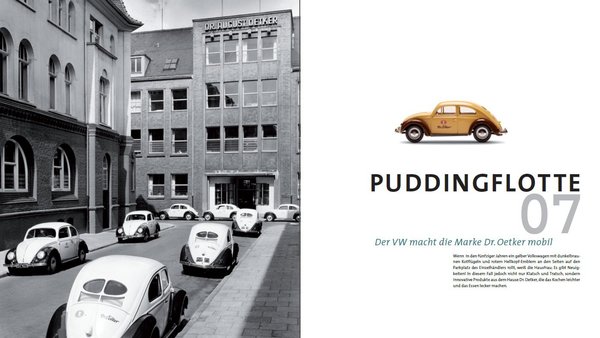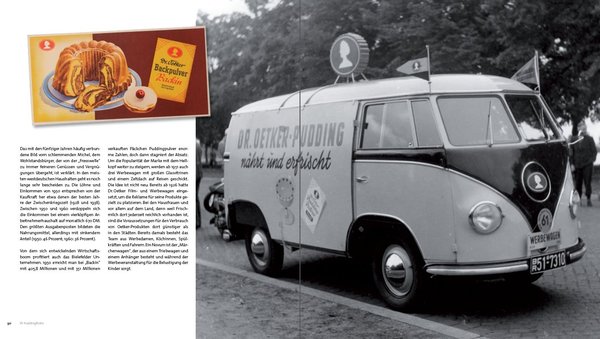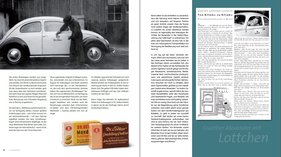December 15, 1945 is a Saturday. The consequences of the Second World War have torn enough wounds into the country, the people and the souls, but this day shows its warm side in this bitterly cold winter. The thermometer shows a few degrees above zero on the day when the story of the book discussed below begins in Bielefeld. Oskar Wehmeier and Hans Castrup set up a "vehicle repair workshop", or "Wehmeier + Castrup" for short, in the Dr. Oetker town of Bielefeld.

Picture treasure unearthed
The starting point of the book is the discovery of two linen-bound 1m long, 50 cm wide picture albums containing a time machine. The two albums contain hundreds of black and white photographs documenting life in the city of Bielefeld in the 1940s, 1950s and 1960s. The focus is on the workshop of our two company founders and their garage, which became an authorized VW dealer as early as 1947. And because the camera proudly captures the development of the company on film from the very beginning and on every occasion, an exemplary documentation of German entrepreneurship of this post-war "start-up" is created over this period.
A history of everyday life in the workshop
The book "Bielefeld fährt Volkswagen" ("Bielefeld drives Volkswagen") uses a wealth of images to trace the history of the repair business in the Westphalian city, which itself is in need of repair. The center is largely in ruins, and scarcity is the greatest resource. How courageous but also far-sighted the young entrepreneurs' decision to open a Volkswagen dealership must have been becomes clear when you see the first pictures in the book.

The VW dealership was established in 1949 on the outskirts of the city, which was partly in ruins. In a very short time, a modern VW dealership is built in the flat-roof style of the garages of the time. And the pictures show that things are tight. Pretzel standards, the first barndoor vans and even a Hebmüller convertible vied for attention in the yard back then and today with the viewers of these pictures.
Germany, economic miracle, Volkswagen
If you want to understand the concept of the economic miracle, you can buy this book. What Volkswagen was for the economic miracle, what the economic miracle was for Germany, what Germany was for Volkswagen - the entire interweaving of this triad becomes clear in the growth of this VW company.

We are there when the first car wash opens, wander through the spare parts warehouse, are at the start of the customer service reception, drink a coffee on the terrace and wait for our VW. Fortunately, this is not just a picture book. We experience this journey through time in the truest sense of the word thanks to the editorial work of Nicole Hille-Priebe, who succeeds in interweaving the various threads in such a way as to create an immersive chronicle. In the background is the history of the German economic miracle, the history of the city of Bielefeld, the everyday life of the newly founded VW workshop and, last but not least, a little company history of the Bielfeld pudding powder dynasty, which of course buys its fleet of VW vehicles from "Wehmeier + Castrup". In February 1960, boss Rudolf-August Oetker personally receives the bouquet of flowers and the key for the 1000th Volkswagen at the dealership.
Nina-Maria Oetker and Axel Struwe
The proximity to the Oetker Group is evident from the conceptual authorship of the book. It comes from the minds of Oetker's wife Nina-Maria and photographer Axel Struwe, who is known in the VW scene for his photography for the book "The First Pretzel Beetle" and the VW Classic Magazine.

The book also deals with the so-called "pudding fleet", with which Volkswagen made the Dr. Oetker brand mobile in West Germany. The book, which began with the founding of a workshop, ends with the words of the husband and his son in an interview.
Bielefeld drives a Volkswagen, what does the reader learn?
Nina-Maria Oetker and Axel Struwe have found and salvaged a treasure trove of photos and share their exhibition with us on over 160 pages and 121 pictures (about 20 of them in color). It is the up-and-coming Volkswagen factory that, like no other company in the 1950s, represents the economic rise of West Germany and at the same time the transition to a consumer society. While owning a car was still a status symbol that not everyone could afford, by the end of the decade it was the Volkswagen: the car for everyone.
Social life is reflected in the images and text. Shooting festivals and carnivals or major sporting events on the cycling track provide a change from long working days. During these years, tens of thousands of people make a pilgrimage to the east of the city to watch the legendary stand-up races or cheer on the children at the traditional soapbox race. And right in the middle of it all is the VW dealer "Wehmeier + Castrup" and its products. All in all, a finely drawn picture of the post-war period in a microcosm, which in some places breaks through this cosmos and looks beyond Dr. Oetker to bring in other perspectives.
Anyone interested in the history of air-cooled VWs and such finely spun background stories will get their money's worth here and, thanks to the generously presented pictures, will not cease to be amazed.
Bibliographical details
- Title: Bielefeld drives a Volkswagen
- Concept: Nina-Maria Oetker, Axel Struwe
- Editing, text: Nicole Hille Priebe
- Publisher: Dr. Oetker, 1st edition 2015
- Format: 230 x 265 mm, paperback
- Scope: approx. 160 pages, 100 b/w images and approx. 20 color illustrations
- ISBN: 978-3-7670-0799-4
- Price: € 24,90
- Buy: Online at amazon.de or in relevant bookstores



















